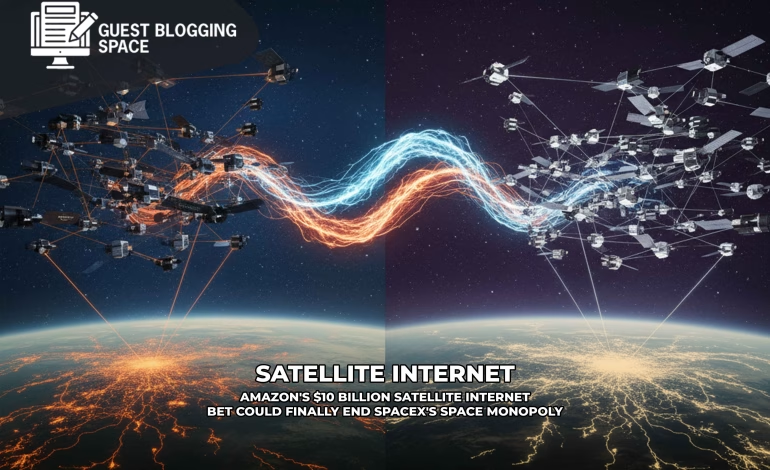Shocking Satellite Internet War: Amazon’s Ultimate Challenge to SpaceX Starlink

The sky just got a lot more crowded, and your internet connection might never be the same. Amazon has thrown down the gauntlet in what’s shaping up to be the most consequential technology battle of the decade—a fight for control of satellite internet that could reshape how billions of people connect to the digital world.
After years of quietly building in the shadows, Amazon officially unveiled its rebranded satellite internet venture, Amazon Leo, on Monday. The announcement wasn’t just another tech launch. It represents a $10 billion bet that Amazon can challenge SpaceX’s overwhelming dominance in a market where Elon Musk’s Starlink has essentially been playing alone for years.
But here’s the twist that makes this story fascinating: Amazon isn’t just competing against any company. They’re taking on a rival that controls nearly two-thirds of all active satellites currently orbiting our planet. The stakes couldn’t be higher, and the odds look brutal.
The Battle for Space Has Only Just Begun
Picture this for a moment. When SpaceX first launched its Starlink satellites back in May 2019, roughly 2,000 active satellites circled Earth. Fast forward to today, and that number has exploded past 11,000—with most of them belonging to Musk’s operation. SpaceX now operates approximately 7,050 active Starlink satellites in low Earth orbit, serving over 5 million customers worldwide.
Amazon, by comparison, has managed to launch just over 150 satellites since April. The math looks almost comically lopsided. Yet Amazon isn’t backing down. The company is moving forward with plans to deploy a massive constellation of 3,236 satellites, positioning them in orbits between 590 and 630 kilometers above Earth—slightly higher than Starlink’s 550-kilometer altitude.
This positioning isn’t arbitrary. The higher orbit offers different advantages for signal coverage and satellite longevity, though it comes with trade-offs in latency and power requirements. Amazon has clearly studied Starlink’s playbook and decided to write their own.
Why Amazon Leo Might Actually Stand a Fighting Chance
On paper, Amazon looks hopelessly outmatched. But dismissing their satellite internet ambitions would be a mistake, and here’s why: Amazon brings weapons to this fight that SpaceX simply doesn’t have.
First, there’s the Amazon Web Services factor. AWS dominates cloud computing in ways that make even Starlink’s satellite lead look modest. Amazon Leo satellites can route data directly into the AWS cloud infrastructure, creating a seamless ecosystem for enterprise customers. Imagine running edge computing workloads from a remote oil rig or processing AI data from an autonomous ship—all without your data ever touching the public internet.
This integration represents something genuinely new in satellite internet. While Starlink offers raw connectivity, Amazon is building connectivity that plugs directly into the digital infrastructure that already powers much of the internet. For businesses already invested in AWS, the value proposition becomes immediately clear.
Second, Amazon’s approach targets enterprise customers first, not consumers. The newly announced enterprise preview program allows select businesses to test production hardware and software ahead of any wider rollout. Amazon Leo Ultra, their top-tier terminal, promises download speeds reaching 1 gigabit per second and uploads up to 400 megabits per second—powered by custom Leo silicon designed specifically for this purpose.
These aren’t consumer-grade numbers. They’re specifications aimed at airlines, energy companies, logistics operators, governments, and corporations that need guaranteed performance in locations where fiber connections don’t exist and can’t be built.
The Technology Powering Amazon’s Satellite Dream
Amazon Leo relies on Ka-band antennas, a choice that offers higher data throughput and greater bandwidth capacity compared to older frequency bands. But the real innovation lies in what Amazon calls optical inter-satellite link technology.
Here’s where things get genuinely impressive from an engineering standpoint. Amazon’s satellites use infrared lasers to communicate with each other at speeds hitting 100 gigabits per second. These laser links create a mesh network in the sky, allowing satellites to relay data across vast distances without constantly bouncing signals down to ground stations.
The technical challenge here is staggering. Imagine maintaining a laser connection between two satellites moving at 15,000 miles per hour, separated by 1,600 miles, while both are constantly adjusting their positions. Amazon claims their optics and control systems have solved this problem after extensive prototype testing in 2023.
This laser mesh technology could give Amazon a significant advantage in certain scenarios. Data can travel between satellites faster than bouncing through multiple ground stations, potentially reducing latency for long-distance communications. For applications like global financial trading, remote telemedicine, or military communications, those millisecond differences matter enormously.
Three Terminals, Three Markets, One Massive Strategy
Amazon isn’t offering just one solution. They’ve designed three distinct customer terminals, each targeting different market segments.
The Amazon Leo Nano represents the entry-level option, though details remain sparse about its specific capabilities and target customers. Based on early reports, this could be Amazon’s play for the portable connectivity market—campers, emergency responders, and remote workers who need basic satellite internet on the go.
This terminal likely represents Amazon’s eventual consumer play, though the company hasn’t announced residential availability timelines. When Amazon does open Leo to home users, this will be the device competing directly with Starlink’s residential service.
Then comes Amazon Leo Ultra, the flagship enterprise terminal announced this week. With its 1 Gbps download and 400 Mbps upload capabilities, Ultra is designed for mission-critical applications. Think maritime shipping companies coordinating global fleets, mining operations in remote locations, or disaster response teams establishing communications in areas where infrastructure has been destroyed.
The pricing strategy remains Amazon’s biggest mystery. Early speculation suggested terminals might cost around $100, dramatically undercutting Starlink’s $349 dish. But those figures came from early project phases, and Amazon has kept completely silent about current pricing. Given the enterprise focus of the initial rollout, expect premium pricing that reflects guaranteed performance levels rather than consumer-friendly rates.
The Brutal Reality Amazon Can’t Ignore
For all of Amazon’s advantages and technical innovations, the company faces obstacles that would crush most competitors. The satellite deficit is only the beginning.
SpaceX has been launching satellites at a blistering pace—sometimes multiple batches per month—using its own Falcon 9 rockets. This vertical integration gives Musk’s company enormous cost advantages and launch flexibility. Amazon, by contrast, relies on launch partners including United Launch Alliance and, awkwardly, SpaceX itself. Yes, Amazon is paying its direct competitor to launch the satellites that will compete against Starlink.
This dependency creates obvious strategic vulnerabilities. SpaceX could theoretically prioritize its own Starlink launches over Amazon’s satellites, though contractual obligations and competitive pressures make this unlikely. Still, the irony is hard to ignore.
Amazon also faces a Federal Communications Commission deadline requiring it to launch at least half its constellation—1,618 satellites—by July 2026. Meeting this deadline will require a launch cadence that Amazon hasn’t yet demonstrated it can maintain. The company has booked more than 80 launches with various providers, but booking and executing are very different challenges.
The financial pressure is intense too. Amazon has committed over $10 billion to this project, making it one of the company’s largest infrastructure bets ever. Andy Jassy, Amazon’s CEO, has called Leo a potential “fourth pillar” for the company alongside its marketplace, AWS, and Prime subscription service. That’s the kind of language that suggests Amazon is prepared to sustain losses for years while building market position.
What This Means for Everyone Stuck With Slow Internet
The competitive implications extend far beyond corporate balance sheets. For the billions of people still lacking reliable internet access, Amazon Leo represents the possibility of genuine choice in satellite internet.
Starlink has undeniably transformed connectivity for rural and remote users. Customers from Alaska to the Australian Outback praise Starlink for bringing high-speed internet to locations where traditional providers deemed service economically impossible. But monopolies, even benevolent ones, rarely serve customer interests long term.
Amazon entering this market could drive innovation on multiple fronts. Pricing might become more competitive as both companies fight for customers. Service quality could improve as each provider tries to differentiate. Hardware might get cheaper as competition forces efficiency improvements.
For enterprise customers, the benefits could arrive even sooner. Organizations that have felt uncomfortable putting all their satellite connectivity eggs in Musk’s basket now have alternatives. Given Musk’s increasingly political profile and controversial statements, some businesses and governments actively seek providers that don’t come with that baggage.
Poland, for instance, has publicly suggested exploring alternatives to Starlink despite the service playing a crucial role in Ukraine’s war effort. That political dimension adds complexity to what would otherwise be a straightforward technology competition.
The Environmental Question Nobody Wants to Address
One aspect that deserves more attention is the environmental impact of satellite mega-constellations. With Amazon planning 3,236 satellites and Starlink potentially deploying 30,000 or more, low Earth orbit is becoming increasingly crowded.
SpaceX reports that its Starlink constellation performs approximately 50,000 collision avoidance maneuvers every six months. As Amazon adds thousands more satellites into similar orbital shells, that number will inevitably increase. Each satellite also represents a risk of creating space debris if something goes wrong.
Satellites have limited lifespans and must be continuously replaced. When they reach end-of-life, they’re typically deorbited to burn up in the atmosphere. But failures happen, and not every satellite deorbits cleanly. The more satellites up there, the higher the risk of cascading collisions that could render certain orbital regions unusable.
Astronomers have also raised concerns about these mega-constellations interfering with ground-based observations. Thousands of bright satellites crossing telescope fields of view create challenges for research that depends on dark, clear skies.
Neither Amazon nor SpaceX has adequately addressed these concerns beyond vague promises about responsible operation and deorbiting protocols. As both constellations grow, regulators may eventually need to impose stricter controls on satellite deployments.
The Bigger Picture: Who Controls the Internet Infrastructure of Tomorrow
Step back from the technical specifications and corporate strategies, and you see something more fundamental happening. Two of the world’s most powerful companies are racing to control the physical infrastructure that will enable global internet connectivity for decades to come.
This isn’t just about who has faster speeds or cheaper terminals. It’s about who shapes the architecture of digital communication. The company that builds the dominant satellite internet network gains enormous influence over which regions get connected, which customers get priority, and how data flows through space.
For remote regions, indigenous communities, developing nations, and anyone far from fiber infrastructure, satellite internet may represent the only realistic path to high-speed connectivity. The choices made now about how these networks are built, who controls them, and how they’re governed will echo for generations.
Amazon’s entry at least ensures this infrastructure won’t be controlled by a single entity. Whether competition between two tech giants ultimately serves public interest better than a single provider remains an open question. But having options beats having none.
What Happens Next in the Satellite Internet Wars
Amazon’s announcement this week moves Leo from vaporware to reality. The enterprise preview program means real customers will soon be testing real hardware connecting through real satellites. Success or failure becomes measurable rather than theoretical.
If the initial enterprise rollout goes smoothly, expect Amazon to expand gradually to additional commercial customers throughout 2026. Full deployment of the satellite constellation is targeted for completion by 2029, with limited commercial service possibly beginning in late 2025 or early 2026.
That timeline gives Starlink years to further entrench its market position. SpaceX won’t sit idle while Amazon builds out its network. Expect competitive responses: improved hardware, faster speeds, new features, and possibly more aggressive pricing.
The next few years will reveal whether Amazon’s advantages—AWS integration, enterprise focus, and deep pockets—can overcome Starlink’s massive head start. It’s entirely possible the market is large enough for both to succeed. Remote connectivity represents a multi-billion dollar opportunity that’s barely been tapped.
When it comes down to satellite internet, what most people and businesses really want is strong competition that pushes everyone to offer faster speeds and lower prices. The nightmare scenario would be Amazon throwing in the towel after a couple of years, handing the whole satellite internet market back to Starlink as the only real player left standing.
Either way, the battle has finally begun. The sky is no longer Starlink’s alone, and that changes everything about the future of internet connectivity.
Frequently Asked Questions (FAQs)
Q1: When will Amazon Leo be available for residential customers?
Amazon has not announced specific timelines for residential service. The current enterprise preview program targets businesses, with wider commercial availability expected in late 2025 or 2026.
Q2: How much will Amazon Leo cost compared to Starlink?
Amazon has not revealed pricing details. Early speculation suggested cheaper hardware than Starlink, but current pricing remains undisclosed and will likely vary by service tier.
Q3: Can Amazon Leo work in urban areas with existing internet?
Yes, though it’s primarily designed for remote locations. Urban customers with fiber access likely won’t see benefits, but it could serve as backup connectivity.
Q4: How many satellites does Amazon need to provide full coverage?
Amazon plans to deploy 3,236 satellites for its complete constellation, with an FCC deadline to launch at least 1,618 by July 2026 for minimum service.
Q5: Will Amazon Leo work with non-AWS cloud services?
Yes, while optimized for AWS integration, Amazon Leo will provide standard internet connectivity that works with any cloud service or online platform.








